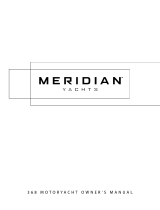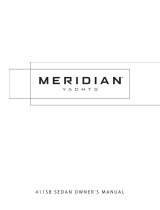
v1.0
89 - Subsystems
Viking Sport Cruiser 61FY
Owner’s Manual
••••••••••••••••••••••••••••••••••••••••••••••••••••••
Oil fill port
under cover
Oil level
visible
A
Bennett Trim Tabs
Your Viking Sport Cruiser 61FY is equipped with industry-standard
Bennett Marine trim tabs. Trim tabs serve three functions:
1. They help the vessel get on plane faster by pushing the bow down.
2. They adjust vessel attitude (bow up; bow down) for optimum com-
fort, efficiency, sea-keeping.
3. They correct a port or starboard list, usually caused by windage or
clustering of passengers to one side.
Using the tabs
In general:– Under normal sea conditions very little or no tabbing is
required to run or bring the vessel onto plane.
In port:– Tabs should be fully lifted in port, and at a dock.
In heavy seas:– Use tabs to keep bow down in heavy seas. In the
case of
following
heavy seas, tabs should be lifted.
Climbing onto plane:– Do not deploy tabs until you are about to accelerate
onto plane. During acceleration, apply tabs in short bursts, as vessel
comes on plane. If tabs are overtrimmed the bow will plow.
Cruising:– In normal seas, watch the bow wave as the vessel is
trimmed – at proper trim the bow wave and spray will move forward
and wake will be reduced.
Do not overtrim – especially at speed!
Coming off plane:– After the vessel has settled off plane, or when
operating at displacement speeds, lift the tabs.
Correcting a list:– If the port side is too low, you want to push down the
starboard bow to balance the vessel. Therefore use the STARBOARD con-
trol for BOW DOWN in small bursts to correct the situation. Paradoxically,
the “starboard” tab control rocker activates the
portside
tab to lift the
port stern. Since the hull must achieve hydraulic equilibrium, the oppo-
site bow (stb) will go down – thus the list will be corrected.Look at the
horizon when operating tabs to judge the amount of tab required.
Maintenance
The Bennett pump (a.k.a. HPU - hydraulic power unit) A for the trim
tabs is at starboard, above the steering gear. Periodically check fluid
level in the HPU. With trim tabs completely retracted fluid level should
be about 2 inches from the bottom of the reservoir (it holds about
22 ounces). Fluid level is not critical.
To refill:– Remove the Lexan cover, and the filler plug on the left side.
Top up with any type of automatic transmission fluid (ATF). Retract
and extend the tabs 3 times. Check oil level again. Be very careful,
valves are tiny and dirt in the oil can cause failure.
Troubleshooting
If you hear the pump running, but the tab doesn’t move, oil probably
needs to be added. If so check for leaks. Also check fuse and voltage.
Check zinc anode on each trim tab; they protect against corrosion.
Trim tab controls
Use tab controls in brief bursts. Push top of button
to lower bow; push bottom of button to raise bow.
• When docked have tabs fully retracted.
• In heavy seas keep the bow down.
• Raise tabs in following seas.
• DO NOT OVERTRIM, particularly at high speed.
Bow down
Bow up
Bow down
Bow up
port stb
Trim tabs (typical)
Hydraulic cylinders generate up to 600 psi
to push tabs down. Tab retraction (bow UP)
opens a valve then the pump removes oil
from the cylinders. This permits internal
springs to retract the tabs, aided by
pressure of moving water.
Note:- Do not push one tab UP, and the
other DOWN at the same time. The pump
cannot respond to that and will likely stop.
port stb
Bridge Salon









